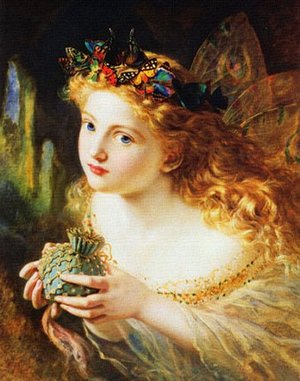Fairy
|
|
- For other uses, see Fairy (disambiguation).
A fairy, or faery, is a creature from stories and mythology, often portrayed in art and literature as a minuscule humanoid with insect-like wings. This word is derived from the name of a place where they were said to live: Faerie, and fairies are sometimes called fairy-folk. The myth appears commonplace across many diverse cultures and traditions. They have many names and many forms.
| Contents |
Celtic mythology
The Celtic peoples have many references to fairies in their myths and legends, and their nature is described in widely different ways. They are also known as 'the little folk', but this can also refer to leprechauns, goblins, menehune, and other mythical creatures. In Ireland, the fairies were known as the Sídhe, and in Scotland, the Daoine Sith, or a great many variant names.
The height of fairies was not always as consistent as is held to be the case today. Traditionally, fairies were often of human height or taller.
One consistent belief amongst the Britons was that the fairy people were weak against cold iron, leading to many of the iron-related superstitions that have existed, some of which survive to this day (for instance, the tradition of placing a horse shoe on one's door).
This belief has prompted some historians and mythological commentators to speculate that the fairies are actually derived from a folk memory of the people that inhabited the island of Great Britain before the Celts arrived. These people would have been armed only with stone, and hence iron would have been the decisive Celtic advantage.
In contemporary belief, fairies are often characterised as fundamentally benevolent in demeanour; this does not, however, hold true in many historical manifestations. The belief in Changeling children, for instance, where the fairies would steal away a mortal child and replace it with one of their own, was widespread in mediaeval times; this motif appears in the folk-songs Thomas the Rhymer and Tam Lin, among others.
Fairies in literature
William Shakespeare's play A Midsummer Night's Dream deals extensively with the subject of fairy-folk and their interaction with a group of amateur theatrical players. This work details the spell cast by the mischievous fairy Puck (at the behest of the fairy-king Oberon) on Oberon's wife Titania, who falls in love with the first mortal she casts eyes upon, the unfortunate Bottom, whom Puck has transmogrified into having a donkey's head.
William S. Gilbert liked fairies and wrote several plays about them. The best is the Gilbert and Sullivan operetta Iolanthe which deals with a conflict between fairies and the House of Lords and, among other issues, touches on some of the practical consequences of fairy/human marriages and cross-breeding in a humorous manner.
Fairies in visual arts
Artists such as Brian Froud, Ida Rentoul Outhwaite. Cicely Mary Barker, Omar Rayyan and Sheila Rayyan, and Peg Maltby have all created beautiful illustrations of fairies.
Conversely, the Victorian painter Richard Dadd was responsible for some paintings of fairy-folk with an altogether more sinister and malign nature. The Victorians in Britain were much taken with the notion of fairies in the wake of the Cottingley fairies photographs, and a number of artists turned to painting fairy themes. Another notable Victorian painter of fairies was the artist and illustrator Arthur Rackham.
Fairies in modern popular culture
Main figure in Irish writer Eoin Colfer's stories about Artemis Fowl. In the first book, Artemis Fowl discovers the existence of an underground world of fairies. Because of this threat, captain Holly Short is sent to the Earth to eliminate Artemis Fowl. Though she doesn't want to admit it, she slowly becomes friends with Artemis, and in the third book they form an alliance to fight the Mafia.
Originally from the Peter Pan stories by J.M. Barrie, but more famous for the Disney version, or the portrayal by Julia Roberts in the 1994 movie Hook. She is also often referred to as a pixie, and leaves a trail of fairy dust (or pixie dust) behind wherever she goes.
Kyliefairy.jpg
In Carlo Collodi's tale Pinocchio the wooden boy receives the gift of real life from the Blue Fairy. In Steven Spielberg's A.I.: Artificial Intelligence (2001), where an android longs to become a real boy, the Blue Fairy is voiced by Meryl Streep.
- Green Fairy
Short but famous cameo of Kylie Minogue in Baz Luhrmann's Moulin Rouge!. When Christian and the bohémiens celebrate life by feasting and drinking absinthe, the Green Fairy appears in their hallucinations, singing samples from The Sound of Music. Because of its green colour, The Green Fairy is also the nickname of absinthe, hence the apparition of a green fairy in the hallucinations of the drunk bohémiens.
See also
- Adhene
- Pari
- Fey
- Fairy tale
- Pixie
- Wichtlein
- Slavic fairies
- Sprite (fantasy)
- List of fairy and sprite characters
- Fairy painting
- Titania's Palace
External links
- Victorian, PreRaphaelite, and other fairies (http://fairies.artpassions.net/fairy.html)
- Kylie Minogue as the Green Fairy (http://www.animallogic.com/film/moulinrouge/greenfairy.html)da:Fe
de:Fee eo:Feo es:Hada fr:Fée ja:フェアリー pl:Bajka sv:Fe (väsen)

